sensor LEXUS LS430 2006 Owners Manual
[x] Cancel search | Manufacturer: LEXUS, Model Year: 2006, Model line: LS430, Model: LEXUS LS430 2006Pages: 419, PDF Size: 11.19 MB
Page 58 of 419
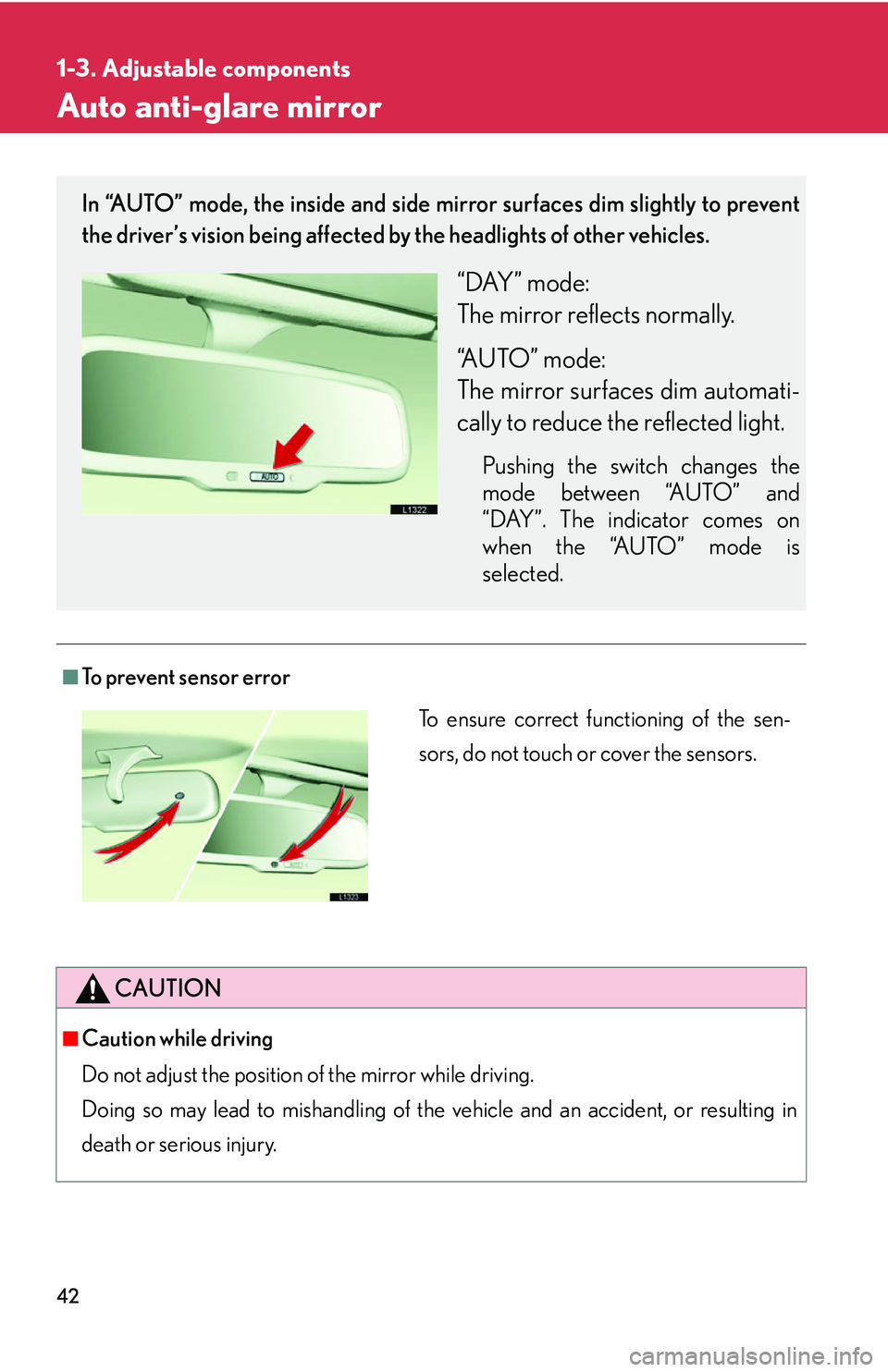
42
1-3. Adjustable components
Auto anti-glare mirror
■To prevent sensor error
CAUTION
■Caution while driving
Do not adjust the position of the mirror while driving.
Doing so may lead to mishandling of the v
ehicle and an accident, or resulting in
death or serious injury.
In “AUTO” mode, the inside and side mirror surfaces dim slightly to prevent
the driver’s vision being affected by the headlights of other vehicles.
“DAY” mode:
The mirror reflects normally.
“AUTO” mode:
The mirror surfaces dim automati-
cally to reduce the reflected light.
Pushing the switch changes the
mode between “AUTO” and
“DAY”. The indicator comes on
when the “AUTO” mode is
selected.
To ensure correct functioning of the sen-
sors, do not touch or cover the sensors.
Page 77 of 419
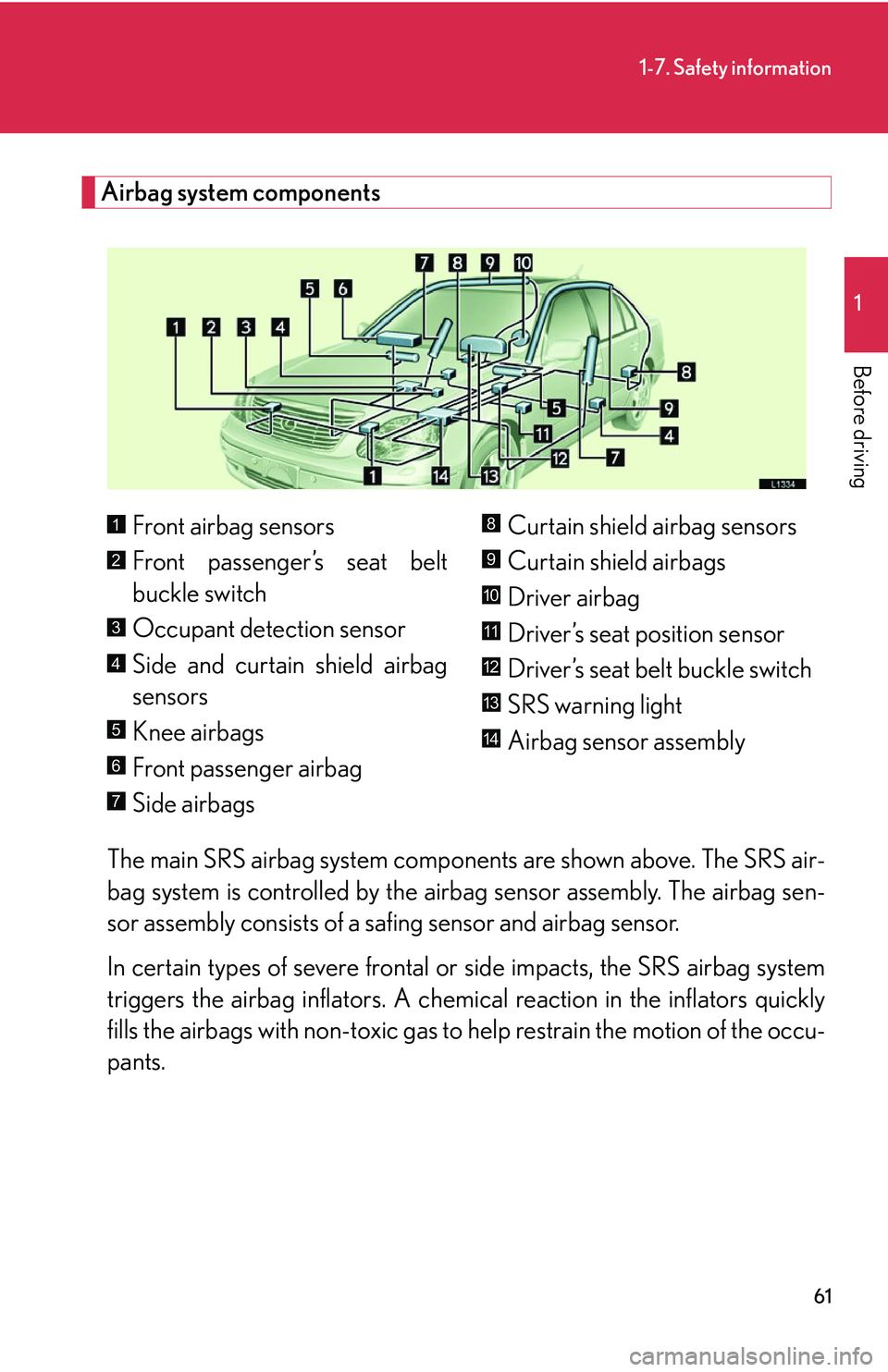
61
1-7. Safety information
1
Before driving
Airbag system components
The main SRS airbag system components are shown above. The SRS air-
bag system is controlled by the airb ag sensor as
sembly. The airbag sen-
sor assembly consists of a safing sensor and airbag sensor.
In certain types of severe frontal or side impacts, the SRS airbag s
ystem
triggers the airbag inflators. A chemica l reaction in the inflators quickly
fills the airbags with non-toxic gas to help restrain the motion of the occu -
pants. Front airbag sensors
Front passenger’s seat belt
buckle switch
Occupant detection sensor
Side and curtain shield airbag
sensors
Knee airbags
Front passenger airbag
Side airbags
Curtain shield airbag sensors
Curtain shield airbags
Driver airbag
Driver’s seat position sensor
Driver’s seat belt buckle switch
SRS warning light
Airbag sensor assembly
1
2
3
4
5
6
7
8
9
10
11
12
13
14
Page 127 of 419

111
2-3. Operating the headlight and windshield wipers
2
When driving
Daytime running light system
The headlights turn on automatically (at a reduced intensity) whenever the
engine is started and the parking brake is released to make your vehicle
more visible to other drivers. Dayt ime running lights are not designed for
use at night.
■Headlight control sensor
■Automatic light off system
The headlights turn off automatically if the engine is stopped and the driver’s door is
opened wh
ile the headlights are turned on.
To turn the headlights on again, turn the key to ON, or turn the light switch off once
and then
back to or position.
■Automatic headlight leveling system
The level of the headlights is
automatically adjusted according to the number of
passengers and the loading condition of the vehicle to ensure that the headlights do
not interfere other road users.
■Customization
The time it takes for the headlights to automatically turn on or off can be changed.
( P.384 )
The sensor may not function properly if an
object is placed on the sensor, or anything
that blocks the sensor is affixed to the wind-
shield.
Doing so interferes with the sensor detect-
ing the level of ambient light and may cause
the automatic headlight system malfunc-
tion.
Page 132 of 419
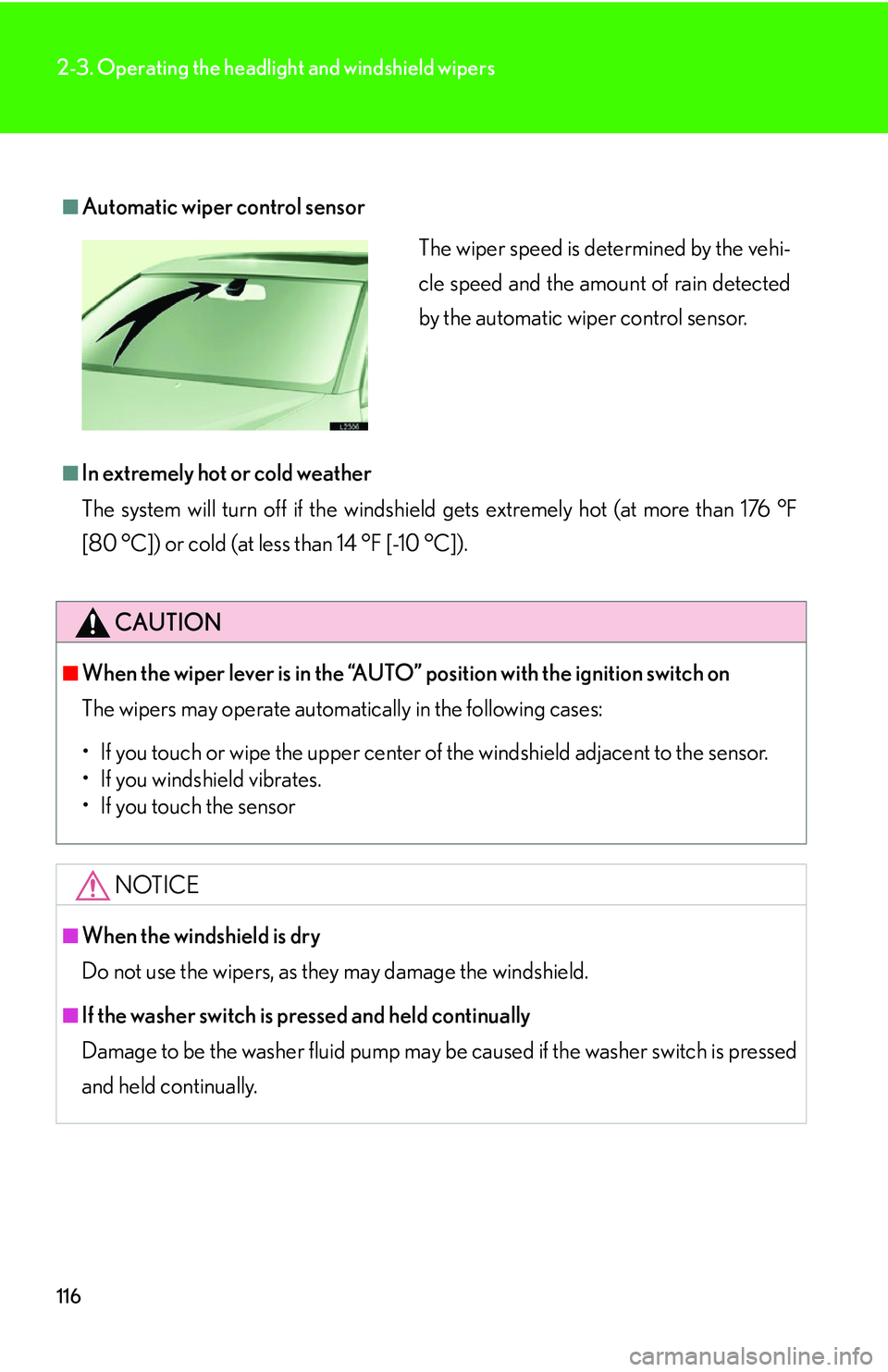
116
2-3. Operating the headlight and windshield wipers
■Automatic wiper control sensor
■In extremely hot or cold weather
The system will turn off if the windshield gets extremely hot (at more than 176 °F
[80 °C]) or cold (at less than 14 °F [-10 °C]).
CAUTION
■When the wiper lever is in the “AUTO” position with the ignition switch on
The wipers may operate automatically in the following cases:
• If you touch or wipe the uppe
r center of the windshield adjacent to the sensor.
• If you windshield vibrates.
• If you touch the sensor
NOTICE
■When the windshield is dry
Do not use the wipers, as they may damage the windshield.
■If the washer switch is pressed and held continually
Damage to be the washer fluid pump may be caused if the washer switch is pressed
and he
ld continually.
The wiper speed is determined by the vehi-
cle speed and the amount of rain detected
by the automatic wiper control sensor.
Page 134 of 419
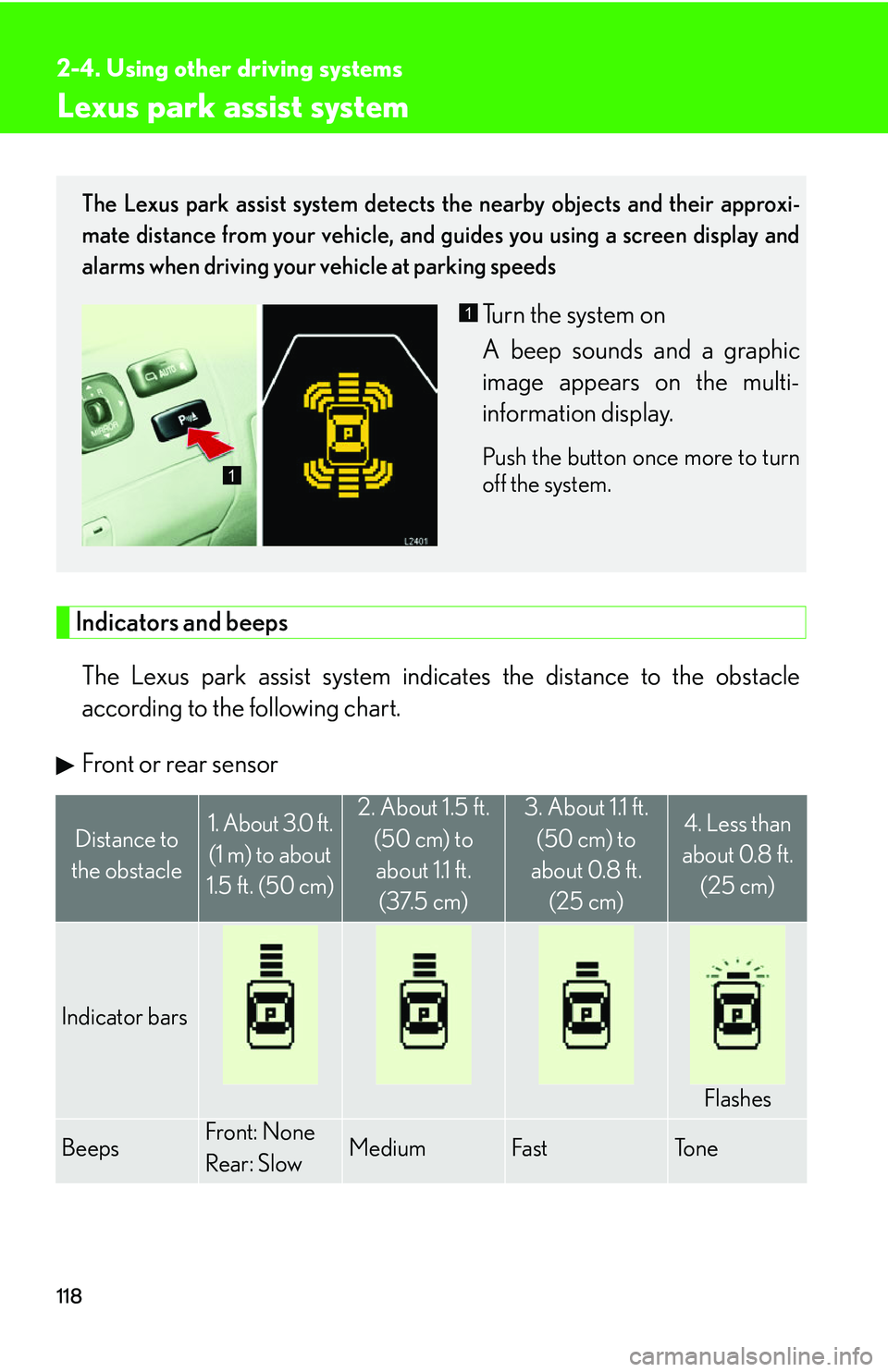
118
2-4. Using other driving systems
Lexus park assist system
Indicators and beeps
The Lexus park assist system indicates the distance to the obstacle
according to the following chart.
Front or rear sensor
Distance to
the obstacle1. About 3.0 ft. (1 m) to about
1.5 ft. (50 cm)2. About 1.5 ft. (50 cm) to about 1.1 ft. (37.5 cm)3. About 1.1 ft.
(50 cm) to
about 0.8 ft. (25 cm)4. Less than
about 0.8 ft.
(25 cm)
Indicator bars
Flashes
BeepsFront: None
Rear: SlowMediumFastTo n e
The Lexus park assist system detects the nearby objects and their approxi-
mate distance from your vehicle, and guides you using a screen display and
al
arms when driving your vehicle at parking speeds
Turn the system on
A beep sounds and a graphic
image appears on the multi-
information display
.
Push the button once more to turn
off the system.1
1
Page 135 of 419
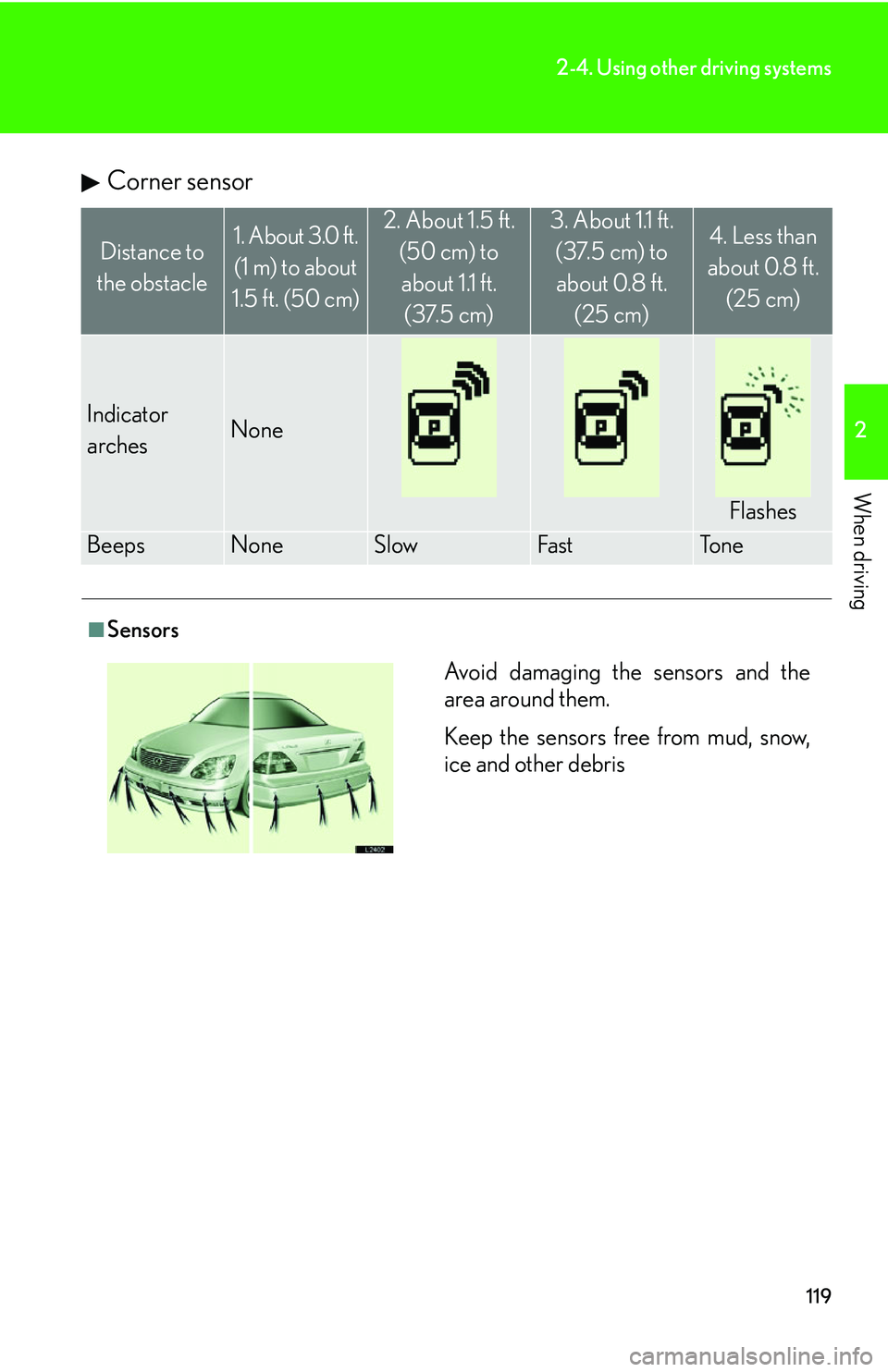
119
2-4. Using other driving systems
2
When driving
Corner sensor
Distance to
the obstacle1. About 3.0 ft. (1 m) to about
1.5 ft. (50 cm)2. About 1.5 ft. (50 cm) to about 1.1 ft. (37.5 cm)3. About 1.1 ft.
(37.5 cm) to about 0.8 ft. (25 cm)4. Less than
about 0.8 ft.
(25 cm)
Indicator
archesNone
Flashes
BeepsNoneSlowFastTo n e
■Sensors
Avoid damaging the sensors and the
area around them.
Keep the sensors free from mud, snow,
ice and other debris
Page 136 of 419
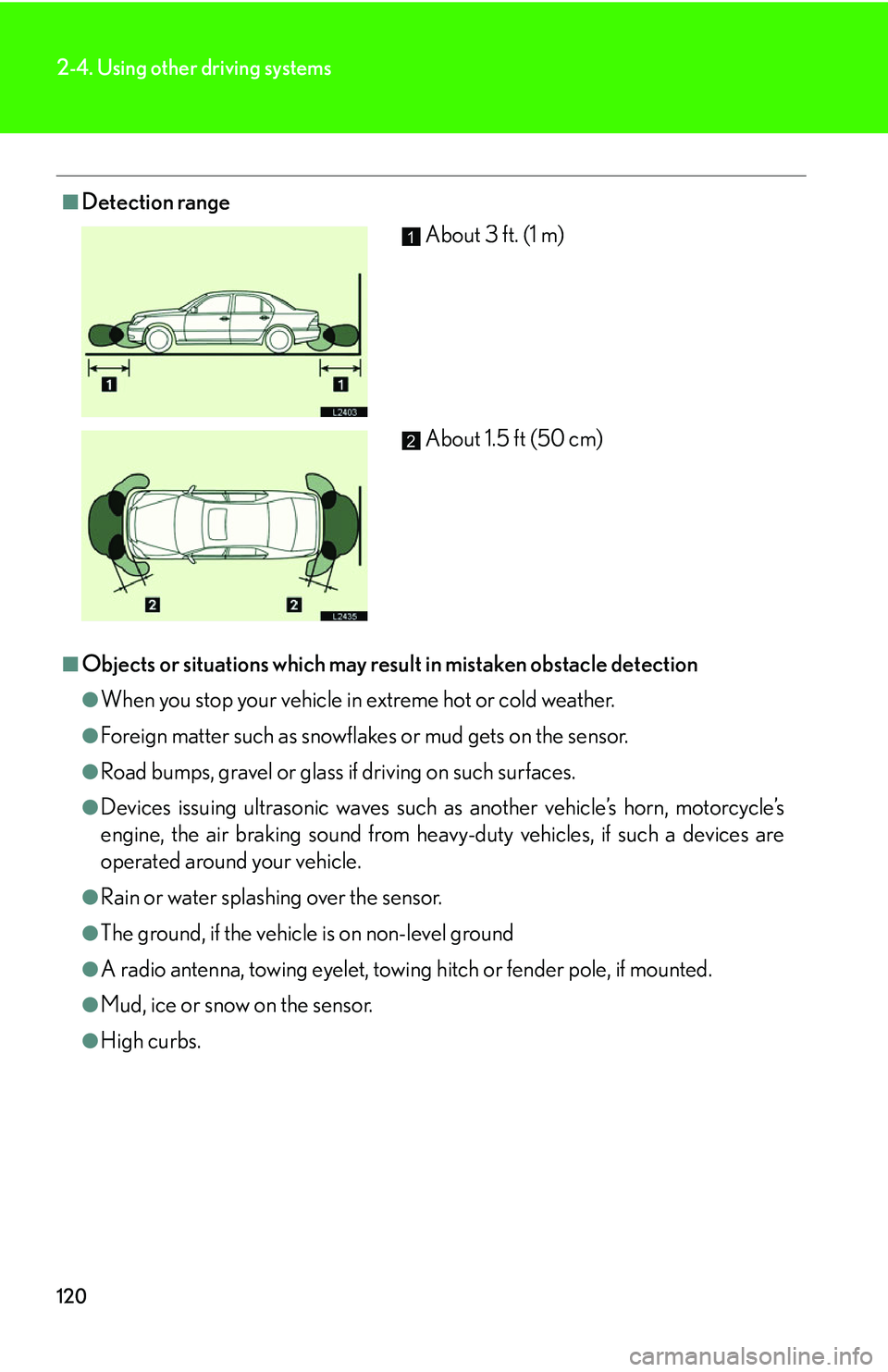
120
2-4. Using other driving systems
■Detection range
■Objects or situations which may result in mistaken obstacle detection
●When you stop your vehicle in extreme hot or cold weather.
●Foreign matter such as snowflakes or mud gets on the sensor.
●Road bumps, gravel or glass if driving on such surfaces.
●Devices issuing ultrasonic waves such as another vehicle’s horn, motorcycle’s
engine, the air braking sound from heavy-duty vehicles, if such a devices are
operated around your vehicle.
●Rain or water splashing over the sensor.
●The ground, if the vehicle is on non-level ground
●A radio antenna, towing eyelet, towing hitch or fender pole, if mounted.
●Mud, ice or snow on the sensor.
●High curbs.
About 3 ft. (1 m)
About 1.5 ft (50 cm)1
2
Page 137 of 419
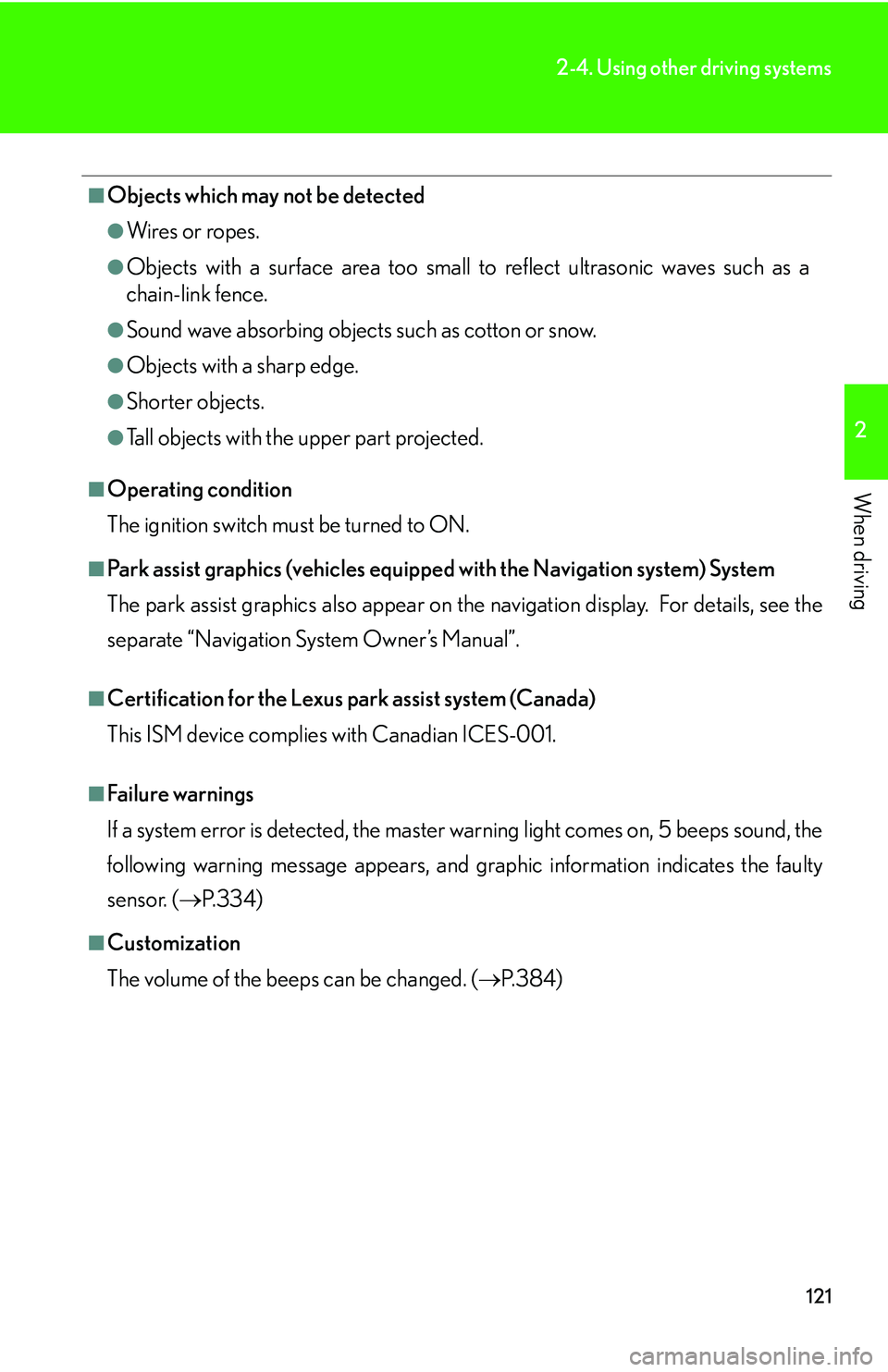
121
2-4. Using other driving systems
2
When driving
■Objects which may not be detected
●Wires or ropes.
●Objects with a surface area too small to reflect ultrasonic waves such as a
chain-link fence.
●Sound wave absorbing objects such as cotton or snow.
●Objects with a sharp edge.
●Shorter objects.
●Tall objects with the upper part projected.
■Operating condition
The ignition switch must b
e turned to ON.
■Park assist graphics (vehicles equippe d with the Navigation system) System
The park assist graphics also appear on the n
avigation display. For details, see the
separate “Navigation System Owner’s Manual”.
■Certification for the Lexus park assist system (Canada)
This ISM device complies with Canadian ICES-001.
■Failure warnings
If a system error is detected, the master warning light comes on, 5 beeps sound, the
fo
llowing warning message appears, and gr aphic information indicates the faulty
sensor. ( P.334 )
■Customization
The volume of the beeps can be changed. ( P. 3 8 4 )
Page 138 of 419
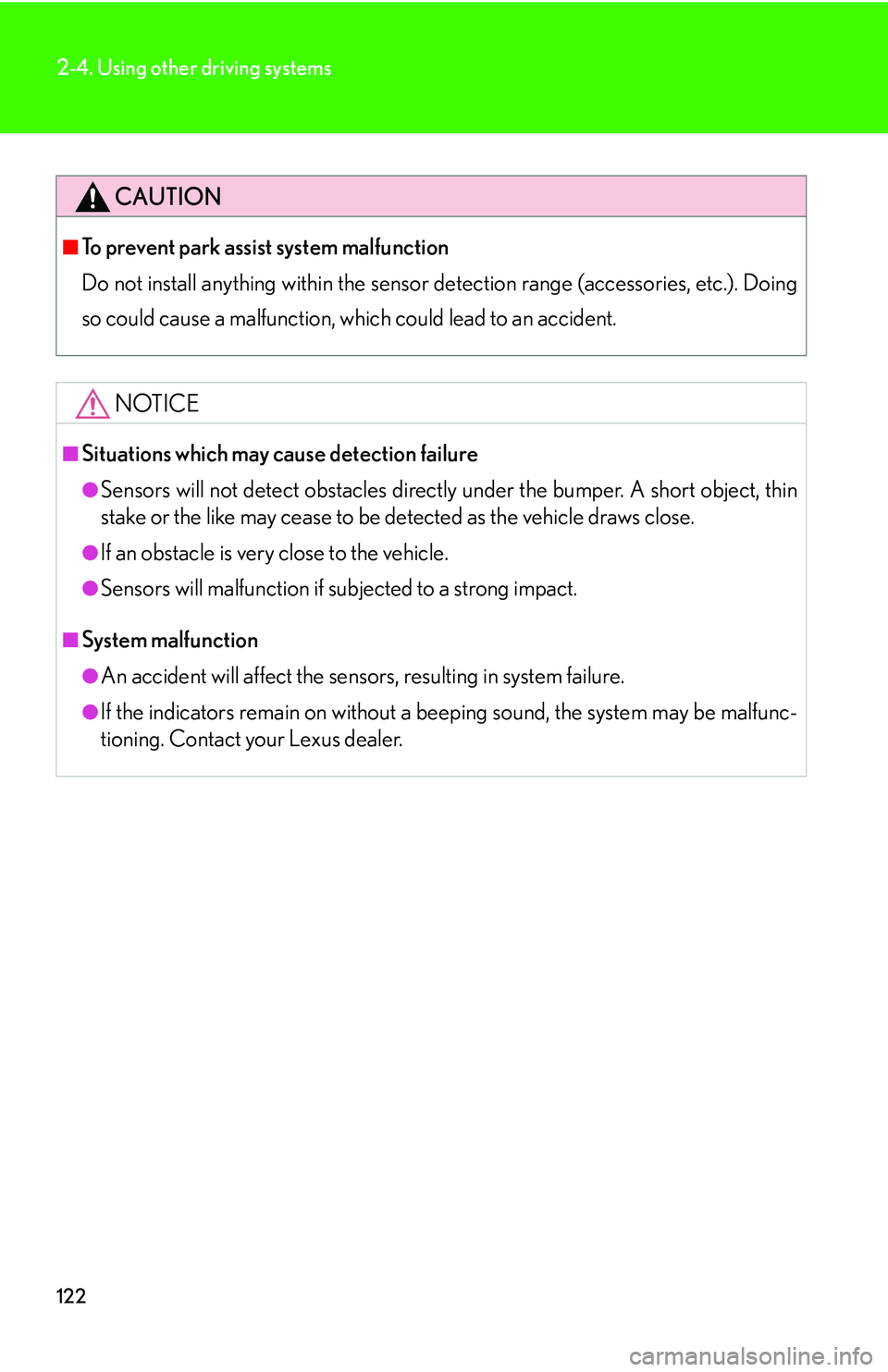
122
2-4. Using other driving systems
CAUTION
■To prevent park assist system malfunction
Do not install anything within the sensor detect
ion range (accessories, etc.). Doing
so could cause a malfunction, which could lead to an accident.
NOTICE
■Situations which may cause detection failure
●Sensors will not detect obstacles directly under the bumper. A short object, thin
stake or the like may cease to be detected as the vehicle draws close.
●If an obstacle is very close to the vehicle.
●Sensors will malfunction if subjected to a strong impact.
■System malfunction
●An accident will affect the sensors, resulting in system failure.
●If the indicators remain on without a beeping sound, the system may be malfunc -
tioning. Contact your Lexus dealer.
Page 147 of 419
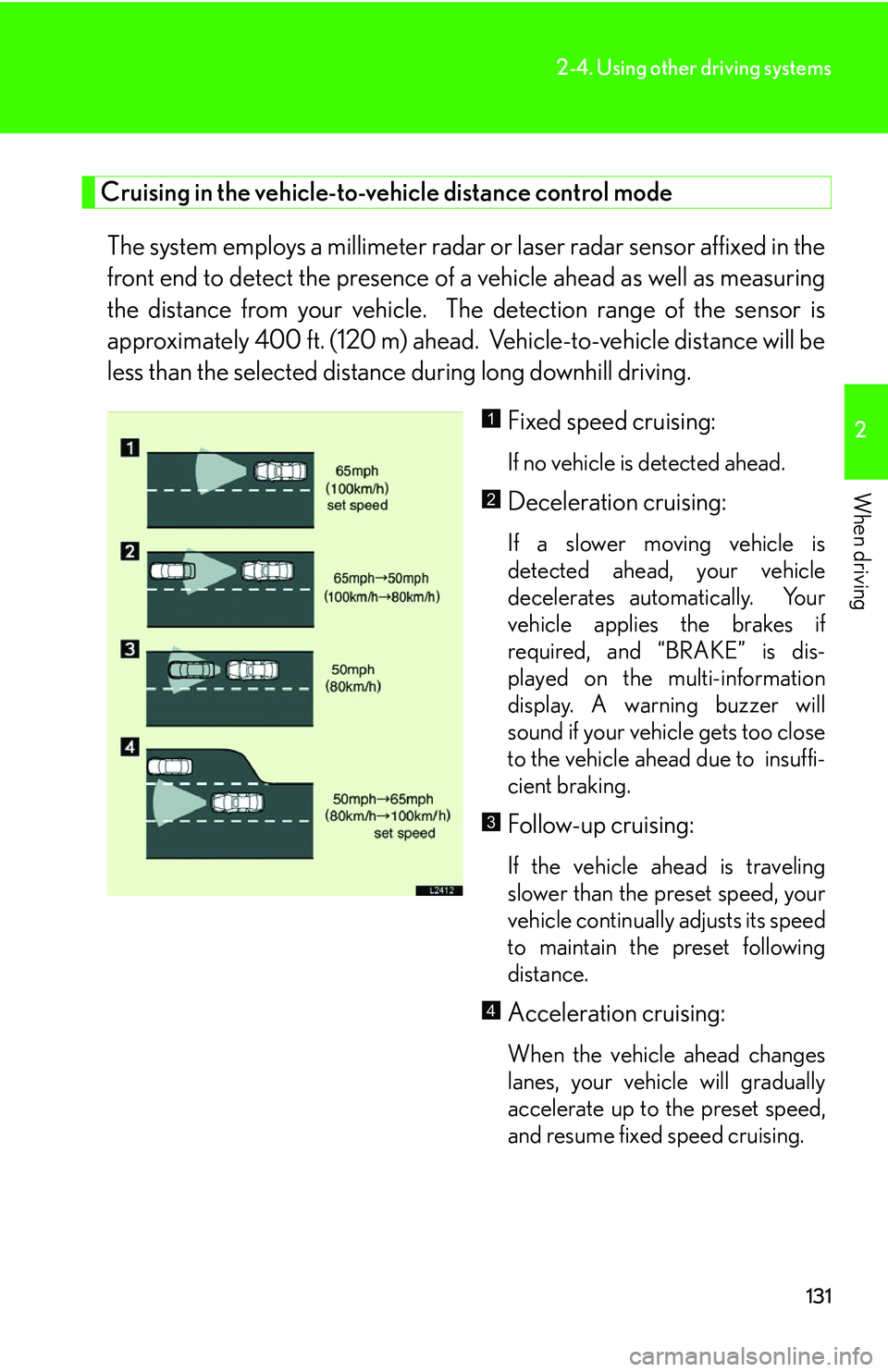
131
2-4. Using other driving systems
2
When driving
Cruising in the vehicle-to-vehicle distance control mode
The system employs a millimeter radar or laser radar sensor affixed in the
front end to detect the pr esence of a vehicle ahead as well as measuring
the distance from your vehicle. The detection range of the sensor is
approximately 400 ft. (120 m) ahead. Vehicle-to-vehicle distance will be
less than the selected distance during long downhill driving.
Fixed speed cruising:
If no vehicle is detected ahead.
Deceleration cruising:
If a slower moving vehicle is
detected ahead, your vehicle
decelerates automatically. Your
vehicle applies the brakes if
required, and “BRAKE” is dis -
played on the multi-information
displa
y. A warning buzzer will
sound if your vehicle gets too close
to the vehicle ahead due to insuffi -
cient braking.
Follow-up cruising:
If the vehicle ahead is traveling
slower than the preset speed, your
vehicle continually adjusts its speed
to maintain the preset following
distance.
Acceleration cruising:
When the vehicle ahead changes
lanes, your vehicle will gradually
accelerate up to the preset speed,
and resume fixed speed cruising.
1
2
3
4